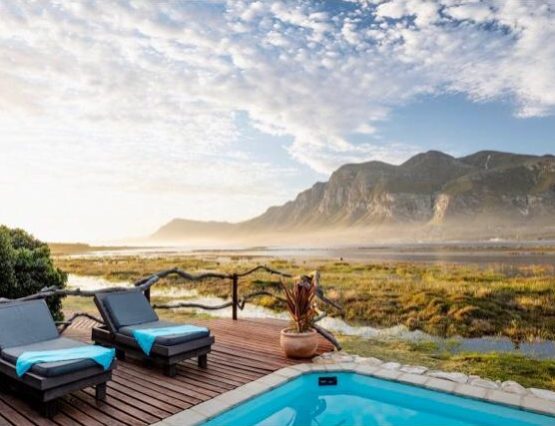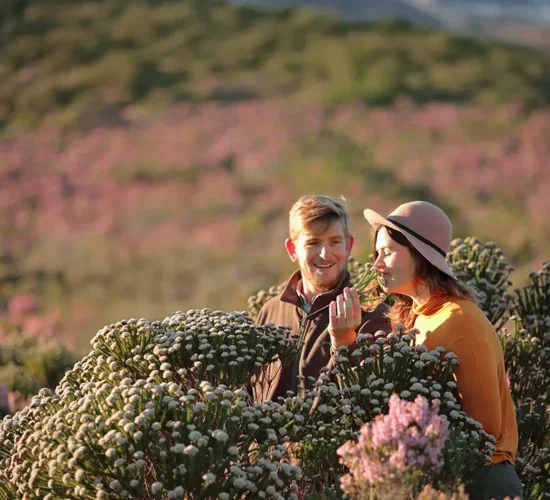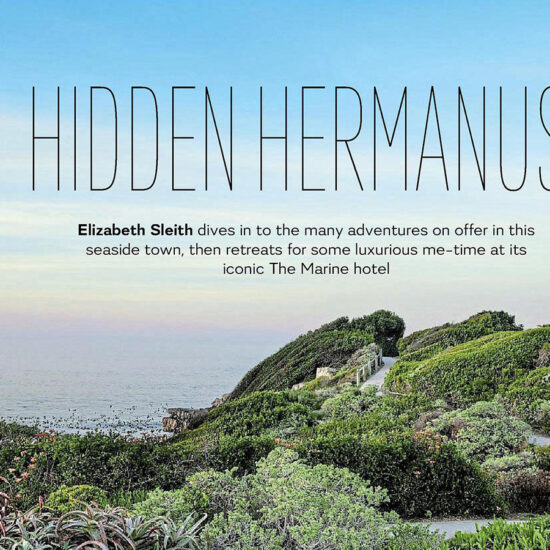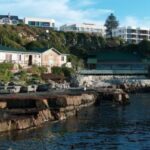
Stanford – a winelands gem
Pippa de Bruyn fell in love with Stanford village near Cape Town in 1990s – and so will you.
Why did it take me 20 years to find this spot? With bits of tape peeling off each spectacle arm, Jo Sinfield looks a little like a mad professor, only better looking. ”I mean, look at that.”
Shaded by the spreading branches of a 500-year-old milkwood, we look across the lake-like estuary – the salt marshes striated with purple and lime; a pink streak of flamingos etched into the blues – to the steep slopes of Maanschynkop Nature Reserve.
“Estuaries are, generally speaking, one of nature’s most productive ecosystems,” Sinfield explains. “This one is particularly important, with lime-rich soil producing incredible plant diversity, and phenomenal bird life. When it breaches, it spills into the Walker Bay Nature Reserve, the most important whale nursery in Africa.
Yet to date, he adds, this entire south bank has been unprotected. “The Coot Club will not just be about discovering something this untouched less than two hour from Cape Town, or about creating a new kind of holiday experience; the real heart is about conserving this unique part of the world.
Sinfield points to a cluster of buildings on the opposite bank: tiny Lego dwarfed by the Cape Fold mountains that belt Africa’s south-western coastline. “That’s the Hermanus yacht club. We want to collaborate with them on sailing courses, regattas… And over there, that’s Maanschjin winery. Imagine, you’ll be able to sail over, pop open a bottle, polish it off with a cheese platter, then head home.” He grins. “Into the sunset, the sound of the halyard clinking against the mast.”
The Coot Club, which opens for bookings in March, is one of seven landowners between Klein River Lagoon and Walker Bay Nature Reserve; of seven, six have agreed to rezone as a protected conservation area. Negotiations are still underway, but if all goes according of the Cape’s newest, 464-hectare nature reserve.
After a dip in Walker Bay, hair damp and feet sandy, I head back to Stanford Village, heart happy, but a little leaden with envy. I first discovered Stanford with the man who would become my husband in the 1990s. The village, declared a conservation area, was the epitome of rural charm. Century-old cottages were fronted with deep verandas and edged with well-tended gardens watered by lei water channels. The reed-fringed Klein River that was the village border attracted abundant birdlife, clusters of yellow-billed ducks grazing below burrows made by giant kingfisher’s egrets and glossy ibis winging up and down the waterway.
On weekend getaways from Cape Town, we would walk the streets, picking out the house in which we would one day raise our children. Of course, we never did. Children bend your lives in places you can’t predict. We still returned for special occasions (memorably my 50th – a decadent celebration at the Stanford Village Guest Farm), with each visit culminating in the usual stroll along the high street, picking out the house we might one day grow old in.
I first heard of Jo’s plans to declare the south bank of the lagoon a nature reserve at Perivoli Lagoon House, the new exclusive-use villa on a 140-hectare spit of land that enjoys the same exquisite view as Coot Club and Mosaic Lagoon Lodge. On a stroll through the fynbos with guide-host Marcelino, we chanced upon a caracal, the green-eyed cat with long tuft-tipped ears – one of three cats regularly sighted here. Like all the properties on the south bank which holidaymakers can currently visit – Mosaic Lagoon Lodge, Reiersvlei Farm and Spookhuis Cottages (site of the new Coot Club development) – Perivoli offers direct access to the Walker Bay Nature Reserve, 10 miles of pristine beach dunes facing west.
“We Chose Stanford for a lot of reasons,” says Lionello Giovannetti, the owner of La Trattoria, who has pulled up a chair. “My father and I travelled all over the country looking for a suitable farm. Finally, I said to him, ‘Have we ever tasted a good gelato while travelling in South-Africa? No. So why don’t we start by making something we know: gelato made the old way.’ We had already looked at a few farms in the Stanford area, so I knew there was a lot of food consciousness here. I could get fresh raw milk, free-range eggs, seasonal berries…It was country life living, but just around the corner from Cape Town. So, we bought a house on the high street and opened Don Gelato. Then the locals started asking: Can’t you make us traditional pasta?” He shrugs. “We found the best-tasting free-range pork in the Hemel-en-Aarde valley. Friends started bringing us what they had harvested. So, La Trattoria Grew organically from the food philosophy that was here already.”
Giovannetti serves plates of pizza frito, bowls of strozzapreti and fettuccine topped with rough-ground mince slow-cooked for six hours. It’s one of the best Italian meals I’ve had I years.
“I hardly ever eat at home,” is William Stephens’s response when I tell him about my evening. “What for, when I can go to a great restaurant?”
We are meandering down the Klein River on the Lady Stanford, the boat he co-owns. We keep half an eye out for birds, but there is also gossip about interesting village characters as we putter past jetties. Earlier that morning I had followed the self-guided historical walk through the village. I learnt that Philippus de Bruyn, who bought the valley farm in 1855, decided to establish a village on the river, auctioning the first plots on May 5, 1856. My father, also Philippus, presented me with a family tree some years before he dies. In it he had traced our bloodline back to my great-great-great grandfather Philippus, who dies in 1885. Did my ancestor once own the village that I wish was home?
On my way back to Stanford Valley guest farm, I visit Sondagskloof, where Cathy Marriot grows organic vegetables for their Manor House restaurant. She regales me with the joys of small-scale farming while showing me the three bungalows she has built into the copes that runs diagonally across her land. These well-designed rentals are popular with Instagram types.
When I admire her courage in leaving the city to create a self-sufficient life, she laughs it off: “We’ve just been lucky.”” You make your luck,” I offer, then head back down the dusty red road to my cottage, surrounded by the plush lawns of Stanford Valley farm. Soon it will be dinner, with Reinder and Elsabe, the owners who have created this affordably oasis. I pour a glass of white wine, as the evening light softens the contours of the Akkedisberg Pass. You make your own luck indeed.
Sorry, the comment form is closed at this time.






